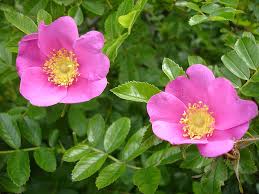**Exploring the Role of Rosa Gallica in Landscape Architecture**

**Rosa Gallica in Landscape Architecture: A Timeless Symbol of Beauty and Elegance**
Rosa Gallica, also known as the Gallic Rose or French Rose, has long been celebrated for its exquisite beauty and timeless elegance. In landscape architecture, Rosa Gallica holds a special place as a versatile and enduring element that adds charm, color, and fragrance to outdoor spaces. In this section, we delve into the various ways in which Rosa Gallica is utilized in landscape architecture, enhancing the beauty and functionality of gardens, parks, and public spaces.
**Historical Significance:**
Rosa Gallica has a rich history in landscape architecture, dating back to ancient civilizations such as the Greeks and Romans, who cultivated roses for their ornamental value and medicinal properties. Over the centuries, Rosa Gallica has remained a beloved flower in garden design, admired for its vibrant colors, delicate fragrance, and resilience in various climatic conditions.
**Design Elements:**
In landscape architecture, Rosa Gallica is valued for its versatility and adaptability to different design styles and themes. Whether incorporated into formal garden beds, informal cottage gardens, or contemporary landscapes, the Gallic Rose adds a touch of romance and sophistication to any outdoor setting. Its lush foliage, vibrant blooms, and graceful form make it an ideal choice for creating focal points, borders, and accents throughout the landscape.
**Functional Benefits:**
Beyond its aesthetic appeal, Rosa Gallica offers several functional benefits in landscape architecture. As a low-maintenance plant, it requires minimal care once established, making it suitable for both residential and commercial landscapes. Additionally, Rosa Gallica attracts pollinators such as bees and butterflies, contributing to biodiversity and ecosystem health. Its thorny stems also provide natural deterrents to unwanted pests and intruders, enhancing security and privacy in garden spaces.
**Cultural Significance:**
Rosa Gallica holds cultural significance in various societies and traditions, influencing landscape design practices around the world. In French garden design, the Gallic Rose is often featured in formal parterre gardens, where it symbolizes romance, elegance, and refinement. In English cottage gardens, Rosa Gallica is prized for its informal charm and nostalgic appeal, evoking images of idyllic country living.
**Environmental Impact:**
Rosa Gallica is well-suited to sustainable landscaping practices, thanks to its drought tolerance and disease resistance. By incorporating native and drought-tolerant varieties of Rosa Gallica into landscape designs, designers can reduce water consumption and chemical inputs, contributing to the overall health and sustainability of the environment. Additionally, Rosa Gallica’s ability to thrive in diverse climates makes it a valuable asset in climate-resilient landscape design, helping to mitigate the impacts of climate change on outdoor spaces.
**Conclusion:**
In conclusion, Rosa Gallica plays a vital role in landscape architecture, enriching outdoor spaces with its beauty, fragrance, and cultural significance. Whether used as a focal point in formal gardens, a border plant in cottage gardens, or a sustainable landscape feature in drought-prone regions, the Gallic Rose continues to inspire designers and gardeners alike with its timeless charm and enduring appeal. As we continue to explore innovative approaches to landscape design, Rosa Gallica will undoubtedly remain a cherished element in the tapestry of outdoor environments, connecting people to nature and enriching the human experience for generations to come.
**Enhancing Outdoor Spaces: Utilizing Rosa Gallica in Landscape Architecture**
**Harnessing the Beauty of Rosa Gallica: Integrating the Gallic Rose into Landscape Design**
Rosa Gallica, renowned for its beauty and versatility, serves as a key element in landscape architecture, elevating outdoor spaces with its charm and elegance. In this section, we delve deeper into the ways Rosa Gallica is utilized in landscape design, exploring its diverse applications and its ability to enhance the aesthetic and functional aspects of gardens, parks, and urban environments.
**Versatile Design Element:**
Rosa Gallica’s versatility makes it a valuable asset in landscape design, capable of complementing a wide range of design styles and themes. Whether incorporated into formal or informal landscapes, traditional or contemporary settings, the Gallic Rose adds a touch of romance and sophistication to any outdoor space. Its vibrant blooms, lush foliage, and graceful form make it an ideal choice for creating focal points, borders, and accents throughout the landscape.
**Formal Gardens:**
In formal garden designs, Rosa Gallica is often used to create structured and symmetrical compositions, adding a sense of order and elegance to the landscape. Planted in geometric patterns or arranged in formal parterres, the Gallic Rose lends a sense of refinement and sophistication to classic garden settings. Its vibrant colors and delicate fragrance enhance the visual appeal of formal gardens, creating a welcoming atmosphere for visitors to enjoy.
**Informal Landscapes:**
In contrast, Rosa Gallica thrives in informal landscapes, where it adds a touch of naturalistic beauty and charm. In cottage gardens and country estates, the Gallic Rose is often allowed to roam freely, intertwining with other perennials and shrubs to create a picturesque and romantic ambiance. Its vibrant blooms and sprawling growth habit create a sense of abundance and vitality, evoking images of idyllic countryside settings.
**Urban Environments:**
Rosa Gallica’s adaptability makes it well-suited to urban environments, where it adds color and vibrancy to public parks, plazas, and streetscapes. In city parks and green spaces, the Gallic Rose provides a welcome respite from the hustle and bustle of urban life, inviting visitors to pause and enjoy moments of tranquility amidst the chaos of the city. Its drought tolerance and low maintenance requirements make it an ideal choice for sustainable landscaping in urban areas, helping to mitigate the heat island effect and improve air quality.
**Historical and Cultural Significance:**
Rosa Gallica holds historical and cultural significance in various societies and traditions, influencing landscape design practices around the world. In French garden design, the Gallic Rose is often featured in historic estates and chateaus, where it symbolizes elegance, refinement, and the romance of bygone eras. In English garden design, Rosa Gallica is prized for its association with cottage gardens and country estates, where it adds a touch of nostalgia and whimsy to outdoor spaces.
**Environmental Benefits:**
Beyond its aesthetic appeal, Rosa Gallica offers several environmental benefits in landscape architecture. As a native plant species, it provides habitat and food for pollinators such as bees and butterflies, contributing to biodiversity and ecosystem health. Additionally, Rosa Gallica’s deep root system helps to prevent soil erosion and improve soil structure, enhancing the overall health and resilience of the landscape. Its ability to thrive in diverse climates and soil conditions makes it a valuable asset in climate-resilient landscape design, helping to mitigate the impacts of climate change on outdoor environments.
**Conclusion:**
In conclusion, Rosa Gallica plays a vital role in landscape architecture, enriching outdoor spaces with its beauty, versatility, and cultural significance. Whether used in formal gardens, informal landscapes, or urban environments, the Gallic Rose continues to inspire designers and gardeners alike with its timeless charm and enduring appeal. As we continue to explore innovative approaches to landscape design, Rosa Gallica will undoubtedly remain a cherished element in the tapestry of outdoor environments, connecting people to nature and enriching the human experience for generations to come.

